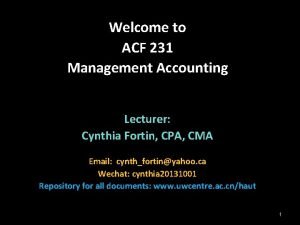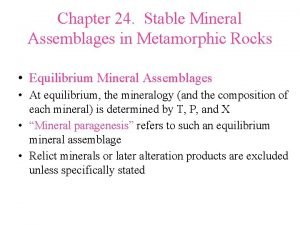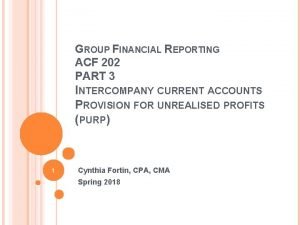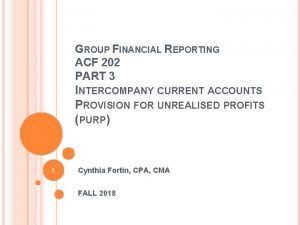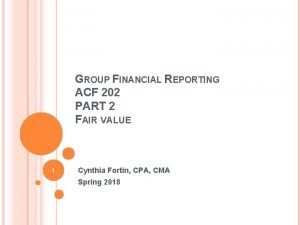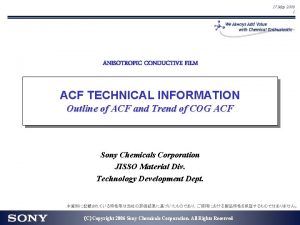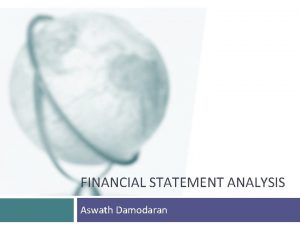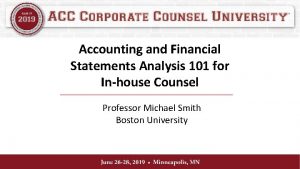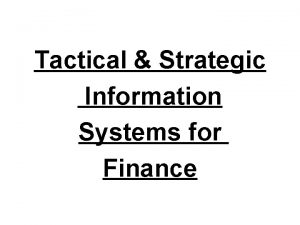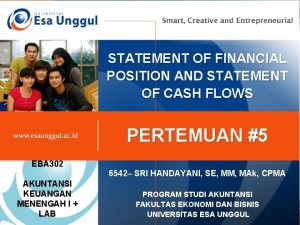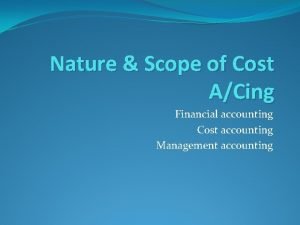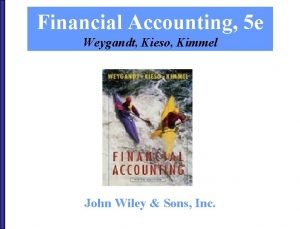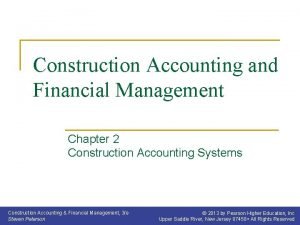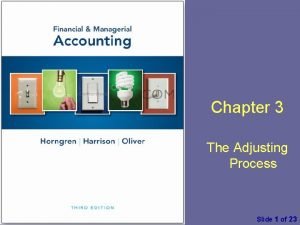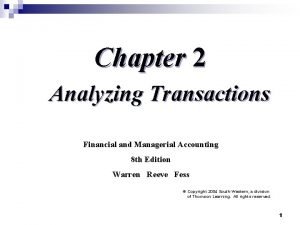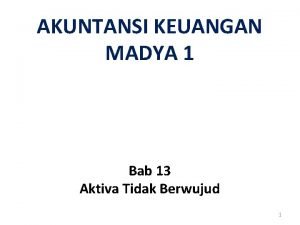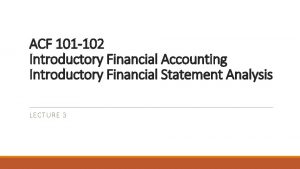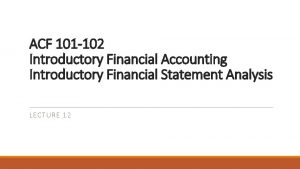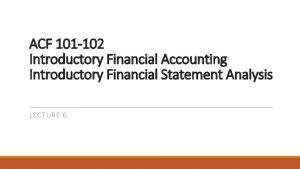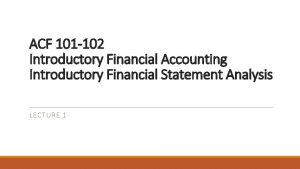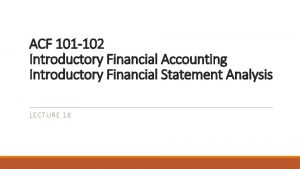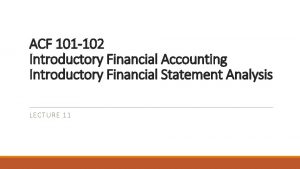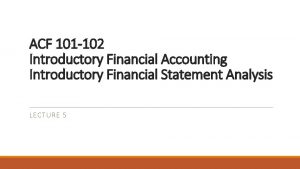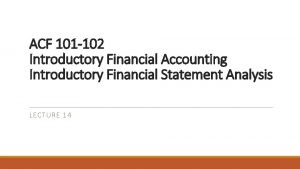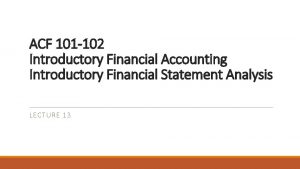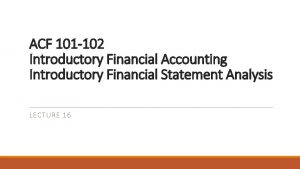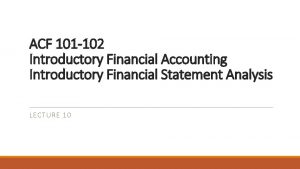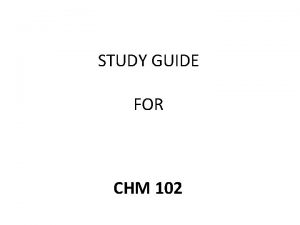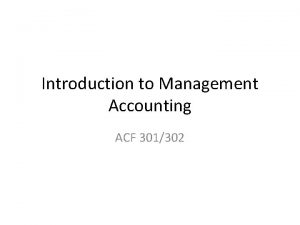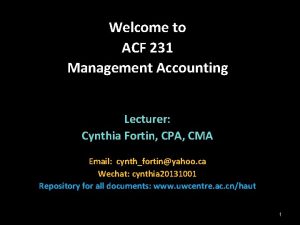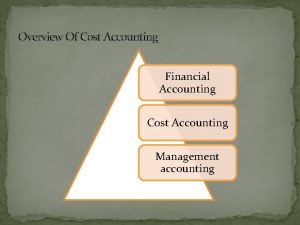ACF 101 102 Introductory Financial Accounting Introductory Financial


































- Slides: 34

ACF 101 -102 Introductory Financial Accounting Introductory Financial Statement Analysis LECTURE 7

Learning Outcome Present information demonstrating quality and clarity of expression, use of terminology, knowledge of format, aptness for the user group. Use of practical and/or numerical and analytical skills (in IT and/or quantitative methods) to produce accounting statements and analyse reports.

Topics Differences in accounting statements for different forms of business Sole Traders Partnerships Limited Liability Companies.

Compare the features of sole proprietorships, partnerships, and corporations….

A sole proprietorship is a separate organization with a single owner. A proprietorship is an individual entity that is separate and distinct from the proprietor.

A partnership is a special form of organization that joins two or more individuals together as co-owners. Each partnership is an individual entity that is separate from the personal activities of each partner.

Corporations are organizations created under state law with an unlimited number of owners. A corporation is a legal entity as well as an accounting entity.

A publicly owned corporation is one in which shares of ownership (capital stock certificates) are sold to the public. The owners of the corporation are then identified as shareholders or stockholders.

A privately owned corporation is owned by families, a small group of shareholders, or single individuals. Its shares of ownership are not publicly sold.

Advantages of the corporate form of ownership include the following: a. Limited liability (i. e. , corporation creditors ordinarily have claims against the corporate assets only, not against the personal assets of the owners) of owners b. Ease of transfer of ownership c. Ease in raising ownership capital d. Continuity of existence e. Separation of ownership and management

One of the potential disadvantages of the corporate form of ownership is that the corporation is taxed as a separate entity.

Identify how the owners’ equity section in a corporate balance sheet differs from that in a sole proprietorship or a partnership…

Comparative Ownership Features Sole proprietorship – a single owner Partnership – two or more co-owners Corporation – created under (U. S. ) state laws ◦ Publicly owned – Owned by the public through the sale of shares; potentially thousands of owners ◦ Privately owned – Owned by families or a small group of shareholders; shares are not sold or traded

Advantages of a Corporation ◦ Limited liability (claims against corporate assets only – not personal assets of managers) ◦ Easy transfer of ownership ◦ Ability to raise capital from thousands ◦ Continuity of existence ◦ Prestige

Disadvantages of a Corporation ◦Unfavorable tax laws (double taxation on distributed earnings) ◦Regulation

Differences in Reporting Owners’ Equity

Proprietorships and Partnerships ◦Owners’ equities = “Capital” ◦Owners’ equities are recorded in the capital account

Corporations ◦ Owners’ equities (Residual interests in the company) also called Stockholders’/Shareholders’ equity ◦ Total capital investment = Paid-in capital (e. g. , $20) ◦ Common stock recorded at par/stated value ◦ Par/stated value = what is printed on the stock ◦ One share × $5 par value = $5 ◦ Paid-in capital in excess of par value ◦ One share × ($20 – $5 par value) = $15

Differences in Reporting Owners’ Equity Shareholders elect a board of directors to look out for their interests Board of Directors ◦ Often include outsiders such as CEOs and presidents of other corporations, academics, attorneys, and community representatives ◦ Can also include insiders – company’s CEO, CFO, etc. ◦ Majority must be independent if stock is regulated ◦ Set strategic direction of the company Senior Managers – run day to day operations

Ethics, Unearned Revenue and Revenue Recognition When uncertainty prevails, conservatism suggests selecting measurement methods that ◦ Understate assets ◦ Overstate liabilities ◦ Understate Equity (and net income) by ◦ Understating revenue and gains ◦ Overstating expenses and losses It is unethical to knowingly overstate assets or equity (net income)

The Adjusting Process in Perspective Transactions Documentation Journal Ledger The complete accounting cycle now becomes Unadjusted Trial Balance Journalize and Post Adjustments Adjusted Trial Balance Financial Statements

The Adjusting Process in Perspective Each adjusting entry affects at least ◦One income statement account ◦One balance sheet account The Cash account is not adjusted The end-of-period adjustment process is reserved for implicit transactions, which anchor the accrual basis of accounting

The Adjusting Process in Perspective Advance Cash Payments for Future Services to be Received Advance Cash Collections in advance for future Services Create Noncash Assets in the Balance Sheet Liabilities in the Balance Sheet Transformed by adjustments into Expenses in the Income Statement When unexpired costs expire Transformed by adjustments into Revenues in the Income Statement When revenues received in advance are earned

The Adjusting Process in Perspective Passing of time and the continuous use of services before paying for them Should be recorded by adjustments as increases in Expenses in the Income Statement and Liabilities in the Balance Sheet Until decreased later by Cash Payments

Adjusting Process in Perspective Passing of time and the continuous rendering of services Should be recorded by adjustments as increases in Revenues in the Income Statement and Noncash assets In the Balance Sheet Until decreased later by Cash Collections

Classified Balance Sheet A classified balance sheet groups asset, liability, and owners’ equity accounts into subcategories Assets are classified into two groups: ◦ Current assets ◦ Noncurrent (or long-term) assets Liabilities are classified into ◦ Current liabilities ◦ Noncurrent (or long-term) liabilities

Classified Balance Sheet

Classified Balance Sheet Current assets = assets expected to be converted to cash, sold, or consumed during the next 12 months (or within an operating cycle if longer) Current liabilities = liabilities expected to be paid within the next year (or operating cycle if longer) • Both are generally listed in the order in which they are likely to be converted/consumed or paid during the coming year

Classified Balance Sheet Liquidity is a company’s ability to pay its immediate financial obligations with cash and nearcash assets The current ratio evaluates a company’s liquidity ◦ Chan Audio’s current ratio is Current Ratio Current assets Current liabilities $532, 500 = 2. 3 $232, 870

Classified Balance Sheet Working capital is the excess of current assets over current liabilities ◦ Chan Audio’s working capital is $532, 500 - $232, 870 = $299, 630 The quick (acid test) ratio removes Inventory (and other less liquid assets such as Prepaid Expenses) from the numerator of the calculation ◦ Chan Audio’s quick ratio is $532, 500 – $260, 200 $232, 870 = 1. 2

Classified Balance Sheet A balance sheet may be presented in ◦ Condensed format - just totals of current and long-term categories ◦ Detailed format - the accounts that make up current and long-term categories ◦ Report format - presents all the accounts vertically ◦ Account format - lists assets to the left and liabilities and owners’ equity to the right

Income Statement Formats Single step - lists revenues and deducts expenses without drawing any intermediate subtotals

Income Statement Formats Multiple step - lists revenues and deducts expenses while drawing intermediate informative subtotals

Income Statement Formats In a multiple-step income statement, Intermediate and informative subtotals usually include the following: ◦ Gross profit (gross margin) - excess of sales revenue over the cost of the inventory that was sold ◦ Operating expenses - recurring expenses that pertain to the firm’s routine, ongoing operations ◦ Operating income - the difference between the usual and frequent in- and outflows ◦ Other (Nonoperating) items – not related to the firm’s principal operations, i. e. , the unusual and/or infrequent flows
 101 102 103 104 105 106 107 108 109 110
101 102 103 104 105 106 107 108 109 110 What is prime factorization of 105
What is prime factorization of 105 Financial accounting and accounting standards chapter 1
Financial accounting and accounting standards chapter 1 Cost and management accounting ppt
Cost and management accounting ppt Acf 231
Acf 231 Nt39538h-c1272b cof data
Nt39538h-c1272b cof data Acf values and standards
Acf values and standards Acf certification requirements
Acf certification requirements Acf values and standards powerpoint
Acf values and standards powerpoint Chemographic diagrams for metamorphic rocks
Chemographic diagrams for metamorphic rocks Aws academy cloud foundations (acf)
Aws academy cloud foundations (acf) Intercompany margin
Intercompany margin Acf 202
Acf 202 Acf 202
Acf 202 Acf portal
Acf portal Sony acf
Sony acf Acf formula
Acf formula Which items are miscategorized balance sheet
Which items are miscategorized balance sheet Finance topics for discussion
Finance topics for discussion In-house financial statement
In-house financial statement Aasb 8
Aasb 8 Computerised accounting conclusion
Computerised accounting conclusion What is the going concern assumption
What is the going concern assumption What is tactical information system
What is tactical information system Statement of financial position account form
Statement of financial position account form Scope of managerial accounting
Scope of managerial accounting Nature of cost accounting
Nature of cost accounting Nature of management accounting
Nature of management accounting Kimmel accounting 5th edition
Kimmel accounting 5th edition Construction accounting and financial management
Construction accounting and financial management Income statement in financial accounting
Income statement in financial accounting Financial accounting chapter 2 solutions
Financial accounting chapter 2 solutions Unit 5 lesson 2 financial accounting
Unit 5 lesson 2 financial accounting Unit 5 lesson 2 financial accountings
Unit 5 lesson 2 financial accountings Financial accounting chapter 13
Financial accounting chapter 13




